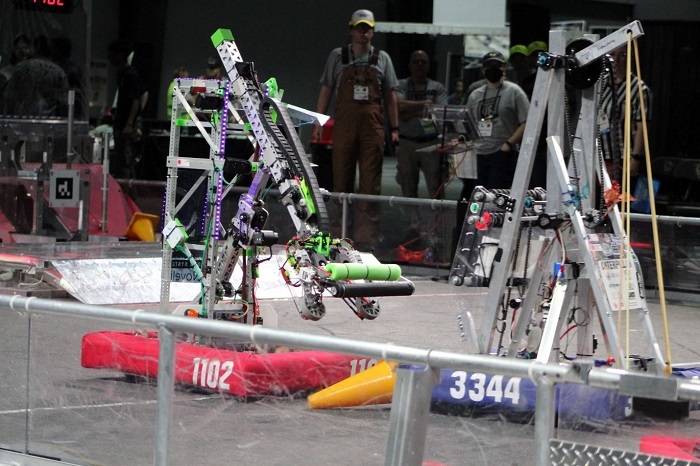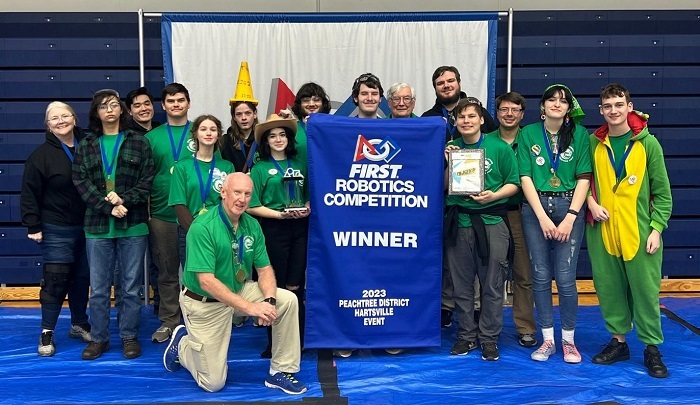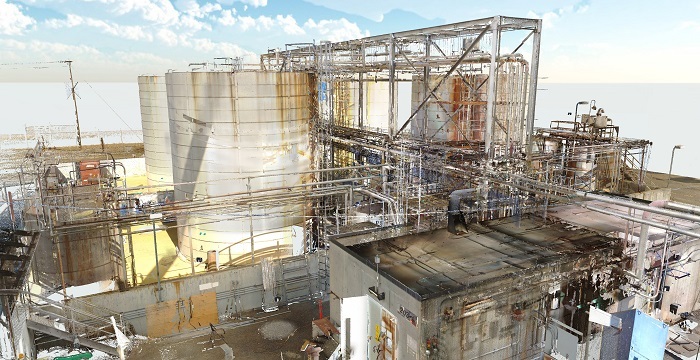 Aiken High School’s M’Aiken Magic team, sponsored by EM contractor Savannah River Nuclear Solutions, competed in a robotics world-championship competition in Houston, Texas. The M’Aiken Magic robot is pictured at left.
AIKEN, S.C. – An EM contractor at the Savannah River Site (SRS) once again sponsored a team from Aiken High School to join an international robotics championship competition.
The M’Aiken Magic robotics team took part in the annual event in Houston, Texas, hosted by FIRST, or For Inspiration and Recognition of Science and Technology. The educational program is offered worldwide to students in eighth through 12th grades.
In the competition, students on each team work together to build a robot from scratch. FIRST’s mission is to inspire young people to be science and technology leaders and innovators as they develop new science, technology, engineering and math (STEM) skills.
“As a company, we at Savannah River Nuclear Solutions (SRNS) understand the importance of a STEM-based education and that many students best learn STEM-based curricula using unconventional means, such as through designing, building and operating a robot,” said Sean Alford, SRNS executive vice president and chief of administration. “We have been financial sponsors of the M’Aiken Magic program for many years.”
EM supports research and development tied to deployment of robotics and use of artificial intelligence for remote operation to tackle cleanup challenges. For example, workers last year introduced a first at EM’s Paducah Site in Kentucky — use of robot technology — to set the stage for future deactivation and remediation work at the former Paducah Gaseous Diffusion Plant. With the Paducah Site in the early phases of deactivating process buildings, site engineers evaluated a robot pipe crawler designed to inspect piping previously used to support uranium enrichment operations.
 Aiken High School’s M’Aiken Magic robotics team placed first in a district event in Hartsville, South Carolina. The win qualified the students to compete in Georgia for a spot in an international robotics championship competition in Houston, Texas.
After winning district competitions in Anderson and Hartsville, South Carolina, M’Aiken Magic went on to the Peachtree District Championship, finishing in second place out of the 50 best teams from Georgia and South Carolina. M’Aiken Magic’s performance qualified the team to attend the world championship in Houston, Texas, and compete against more than 600 teams.
In Houston, the event was divided into eight divisions, each with about 70 teams. After each division plays two days of three-on-three style qualification matches, teams are seeded based on their performance. The top eight seeds select their alliance partners to play in the divisional tournament.
“Our team already knew it was going to be an uphill battle when we discovered that our division not only included two of the reigning world champion teams, but also the number-one ranked robot in the world from this season,” said Ambrose Wiering, who works with robots at SRS while mentoring the team. “But M’Aiken Magic has never been a team to shy away from a challenge. And after the second day of qualification matches, they ended up seeding ninth out of the 77 teams in their division.”
This meant that when the world’s top-ranked team, from the Canadian province of Ontario, picked the five-time world champion team from California to play with it in the tournament, M’Aiken Magic shifted into the eighth seed spot and became an alliance captain. M’Aiken Magic selected team Up-A-Creek robotics from Colorado and team GEMS from Michigan as alliance members.
In the double-elimination bracket, M’Aiken Magic’s alliance faced off against the top-seed alliance. In a stunning upset, the underdogs were victorious.
M’Aiken Magic fell short in its next match, falling into the lower bracket where the teammates found themselves needing a win to survive. According to Wiering, they played their hearts out and lost their last match of the season by a razor-thin margin of 190-192. The team that eliminated M’Aiken Magic went on to win the division.
“This season has been the most successful season in recent memory for our team,” said Wiering. “We hope to return to the world stage next season.”
Any students interested in joining the team can reach out to maikenmagicrobotics@gmail.com
for more information.
“I want to thank Savannah River Nuclear Solutions for their generous financial support of our program. Due to your contributions, our program has made a significant educational impact across Aiken County,” said Wiering. “Without SRNS, this amazing experience would not have been possible, much less winning a few matches against the best of the best, an unbelievable achievement for this team.”
-Contributor: DT Townsend
 This image of the Hanford Site’s Plutonium Uranium Extraction Plant demonstrates how a 3D laser scanning tool is used to capture the layout of facilities being prepared for demolition.
RICHLAND, Wash. – A team of designers with EM Richland Operations Office contractor Central Plateau Cleanup Company (CPCCo) is using 3D laser scanning technology to gather data to help workers prepare some of the facilities on the Hanford Site for demolition.
The process uses laser light to capture information about the surface and shape of an object from different perspectives. The system collects millions of data points and blends that information with high quality photos to create scans capable of highlighting the smallest surface detail.
The amount of detail collected allows designers to build the most accurate 3D computer models possible. The models provide an exact layout of a facility and its contents, including flanges, pipelines, tanks, and valves, all the way down to the nuts and bolts.
“Anytime we can capture comprehensive layout and configuration data in hazardous areas, some of which have not been explored in decades, that’s a big win for worker safety,” said Mark French, EM division director for Hanford’s Central Plateau Cleanup Project. “When workers are required to make physical entries, knowing system layouts and configurations allows for robust planning, which reduces risk and makes the job more efficient.”
 Workers with EM contractor Central Plateau Cleanup Company used 3D laser images of the Reduction-Oxidation Plant on the Hanford Site to identify safe locations for cutting into a concrete wall.
CPCCo is deploying the 3D technology at cleanup projects across Hanford’s Central Plateau, including at the Plutonium Uranium Extraction Plant (PUREX), Waste Encapsulation and Storage Facility (WESF) and Reduction-Oxidation Plant (REDOX). The data not only helps with the development of work packages, sampling plans and demolition preparation, but it can also be used to conduct virtual walk-throughs of facilities.
At PUREX, crews are using digital models of the tanks, structures, pipelines and ancillary equipment to support ongoing cleanup activities. For crews at WESF, 3D scanning assisted with design modifications to the building to prepare for installation of equipment that will transport nearly 2,000 radioactive capsules from underwater pools in the aging facility to a new dry-storage pad. At REDOX, 3D scans were used to establish locations for workers to cut into a concrete wall to install a new roll-up door, which will enable the removal of contaminated equipment as the facility is being prepared for demolition.
“We want to show our crews what the facilities look like right now; we want to eliminate the unknowns,” said Stephen Papenfuss, CPCCo designer and engineer with the Inner Area End States team. “In the past, the projects have had to rely on old pictures and drawings that can take a long time to find and might not best represent conditions inside the facilities today. With the 3D images and models, everybody can be working off the same, up-to-date information.”
-Contributor: Mark McKenna
|